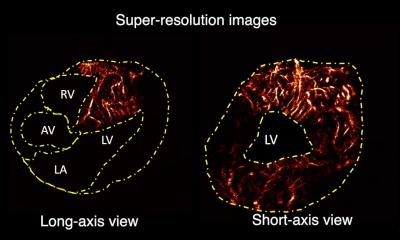Characterising plaques with millimetre-waves
The Plaque-CharM project funded by the German Federal Ministry of Education and Research is to develop novel sensor technology that can characterise arterial tissue in the smallest space – the tip of a catheter.

The partners of the Plaque-CharM project, based at the Leibniz Institute IHP (Innovations for High Performance Microelectronics), are: Primed Halberstadt Medizintechnik GmbH, the Chair for Healthcare Telematics and Medical Engineering and the Institute of Micro and Sensor Systems at the Otto-von-Guericke University Magdeburg, the Chair for Electronic Circuit Technology at Ruhr-University, Bochum, and the Clinic for Cardiothoracic and Vascular Surgery at University Hospital, Giessen and Marburg GmbH.

The partners of the Plaque-CharM project, based at the Leibniz Institute IHP (Innovations for High Performance Microelectronics), are: Primed Halberstadt Medizintechnik GmbH, the Chair for Healthcare Telematics and Medical Engineering and the Institute of Micro and Sensor Systems at the Otto-von-Guericke University Magdeburg, the Chair for Electronic Circuit Technology at Ruhr-University, Bochum, and the Clinic for Cardiothoracic and Vascular Surgery at University Hospital, Giessen and Marburg GmbH.
This could help to diagnose arteriosclerosis at an early stage, leading to improved prevention of heart attacks and strokes. Dr Chafik Meliani, the project co-ordinator at the Leibniz-Institute IHP (Innovations for High Performance Microelectronics), discussed the venture with EH correspondent Bettina Döbereiner
The interdisciplinary research project began when Professor Sebastian Vogt MD, Head of the Research Laboratory at the Cardiothoracic and Vascular Surgery Clinic in Philipps University of Marburg approached Professor Wolfgang Mehr, Director of the Leibniz Institute IHP. Prof. Vogt’s request: the development of a novel diagnostic instrument to help characterise arterial tissue to detect dangerous plaques and distinguish these from asymptomatic plaques. At IHP Prof. Vogt was knocking on an open door.
The project, involving five partners, rolled out in September 2012 to begin a three-year schedule financed with €2.3 million by Germany’s Federal Ministry of Education and Research.
The term Plaque-CharM is derived from the characterisation of plaques via millimetre-waves. ‘What we would like to prove is that in the frequency range of millimetre-waves we can determine characteristics of the arteries that we cannot necessarily see with other procedures,’ Dr Meliani explains. This especially includes the distinction between fatty and calcareous arterial plaques and healthy arterial walls. ‘The frequency range of the millimetre-waves has not yet been fully researched for medical applications, we really are at the very beginning here.’
The IHP-BiCMOS technology developed and planned for the sensor at the IHP is indeed innovative, with add-ons also developed at the Institute, which facilitate on-chip antenna for the integration of biosensors, for example. The research project is currently in its first phase. The objective is to prove the principle experimentally, to systematically characterise tissue in the Gigahertz range and to build a first demonstrator. Already the first success has been observed with initial test structures – a sufficient phase difference was determined during transmission measurements for different types of tissue in the 30 Gigahertz range. ‘This is proof for us that we can indeed see a difference in tissue structure with the application of microwaves,’ Dr Meliani confirms.
In phase two, the objective will be to miniaturise the sensor to such an extent that it fits into the top of a catheter, with a diameter of around 1 millimetre to 500 micrometres and a length of a few millimetres. There will also be issues of biocompatibility, such as the question of temperature, because the sensor must not warm up in the bloodstream. However, a resolution for this issue is already being examined. Even if at first glance the warming up of a sensor may appear inconsequential from an electrical engineer’s perspective, it isn’t from a medic’s point of view. That is exactly what Dr Meliani finds so fascinating about this project: ‘Traditionally, electrical engineers are not that familiar with doctors and vice versa. We each have our own ideas that we contribute to the project, making everything extremely dynamic. This is something new for everyone involved – and it is extremely exciting.’
Profile:
Chafik Meliani MSc PhD gained his electrical engineering degrees in 1999 and 2003, from the University of Denis Diderot, in Paris and from 2000 to 2003mwas working for Alcatel in Paris, on the design of high bitrate circuits for optical communication systems. In 2003, he joined the Ferdinand-Braun-Institut für Höchstfrequenztechnik (FBH) in Berlin, where he was involved in IC design for communication and radar systems and, from 2008 to 2011, led the institute’s power amplifier group. Dr Meliani joined the Leibniz Institut für Innovative Mikroelektronik (IHP) in 2012, heading the research group mm-wave Wireless.
19.12.2013











